6th August 2025
All of the long games this session featured at least one form of transport to keep the 11 gamers occupied.
This time the pre-booked through Discord game was Roads & Boats. Fresh from the task of industrialising India last session, four sat down to play Roads & Boats, a game that could easily be sub-headed as Logistics: The Game. Hundreds of tiny, fiddly cardboard chits, artwork you’d expect to see on a parent’s fridge, an array of possible interactions, oh, and some donkeys. It was time for Simon to continue his slow but steady indoctrination of others into the cult of Splotter games. Two Dutch guys creating complex games in their spare time with minimal production runs. They are never a thing of beauty aesthetically but are great games all the same (previous turn outs at the club have included Antiquity and Bus).
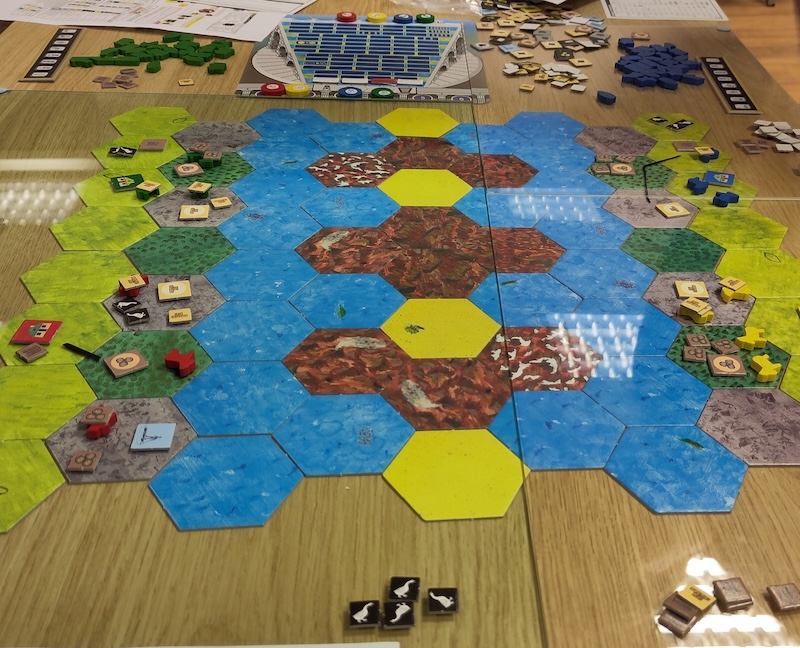
The game board is modular – as in there are a stack of hexes of varied terrain (pasture, forest, rocks, mountains, desert and water) that can be placed to make one of the many available maps or drafted to create your own. This is then covered with an acetate sheet (or upgraded to plexiglass) that holds it all in place and can be drawn on to create roads and bridges as they are built. Players start with 3 donkeys (carry 2 goods, move 1 space), 2 geese (providing quills for research), some boards and a piece of stone. With these simple tools they head off to create their own splendid empire. Those precious resources are required to create producers, which then produce further goods, which in turn are required to produce other goods, and so on. For instance a wooden board can be used to produce a woodcutter on a forest hex, who will then produce one log each turn. This log can go through a Sawmill to produce two boards (the Sawmill itself costing 2 boards and a stone to build), with each hex limited to a single producer. The catch is that the only goods owned by a player are those that are physically on one of their transports. A nicely stacked stash of stone isn’t yours, anyone can just amble by and pick it up.
The aim of the game is to accumulate wealth - bearing in mind that said wealth needs to be on a transport to be yours. At the end of every turn you have the option to build a brick in the monument using goods that are in your starting hex (still not yours technically). This is built in rows, with each row worth 20 points at the end of game, split depending on who has bricks in the row. The game itself will always add a brick every turn, and the building acts as a timer for game end. Basically it all boils down to creating efficient logistical networks. Efficient.
After repeated warnings that using our one stone to make a road would prevent us from building a Quarry to get more stone and probably cripple us, the first moves were fairly cautious, mainly following Simon’s lead to get a Woodcutter chopping down trees for much needed wood, a Sawmill to turn said wood into boards, needed for most buildings and production, and a Quarry for that all important stone. Except for Darren who dove straight into diversifying his transport fleet by eschewing the Sawmill in favour of a Raft Factory. Soon the first roads were starting to be drawn on the plexiglass, enabling some faster movement across the board, and while Simon started researching, Jyo and Steve got distracted by trying to find lovely paddocks for their donkeys to breed in (definitely done in a serious manner with absolutely no jokes that would not pass a censor). Donkeys, and indeed geese, are produced, or rather reproduced, by putting 2 of them alone in a pasture. And by alone, it means no buildings, no other transports, and no goods, not even a plank of wood – these animals are notoriously shy, unassuming creatures, they wouldn’t say boo to a … never mind. Nevertheless Jyo did consistently try to argue that a sawmill was a perfect breeding ground, supposedly with a swarm of workers, giant buzzsaws and piles of sawdust adding to the romance of the scene.
You want donkeys on rafts? That can be provided, as Darren showed, sending a lone donkey off to cruise the waters, heading swiftly towards the settlement Jyo had been building, in order to ‘procure’ some much needed boards – the consequence of having built a Raft Factory before a Sawmill (deciding that a bit of scavenging rather than building was efficient). Alongside carting off handily available planks the donkey was also responsible for building the first wall of the game – walls act a bit like gates, allowing the builder to pass through, but causing all other players to detour around, or bash the wall down using transports and boards. This eventually, and predictably, led to Jyo and Darren building little mazes in each other’s areas. Meanwhile Steve contented himself with building a wall separating ‘his’ area from where Simon was researching up his tech tree to learn the skill of row boat making – with no intention whatsoever of using this new-fangled invention to completely bypass Steve’s wall.
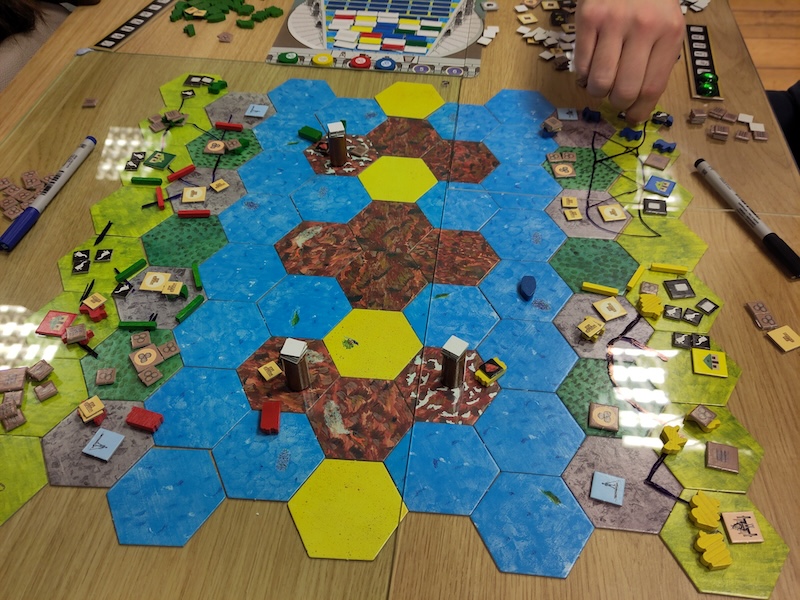
Eventually everyone had waterborne transportation available, and Jyo was first to build a mine in the middle island, randomly producing either ore for building trucks and steamships, or gold for points and producing more points via producing coins and then shares. Steve and Darren soon had also built mines, whilst Simon used his speedy row boats to use the mine that Steve built. By this point there were various road networks, dividing walls and multiple geese across the board, and the mechanics of the game were making sense. The clock was ticking however, and so the decision was soon made to call it after a couple more turns, during which Simon managed to get an Oil Rig erected in the water (producing fuel used for, you guessed it, producing more stuff) whilst competing with Steve for any gold that came out of the contested mine. The last turn saw everyone scurrying back to their bases carrying whatever they could, in a last-ditch effort to build more blocks on the monument for those ever elusive points.
At the point we called it Darren ended up just ahead of Jyo, mainly due to being lucky in getting all 3 gold out of the mine – the next turn would have seen Jyo get her 3rd gold for another 10 points that would have put her ahead. Simon was just behind, but with his shiny tech of row boats and oil rigs he would have surged ahead with the ability to turn gold into coins if a few more turns had been played out. Who knows what Steve might have achieved though, he had upgraded from breeding donkeys to using them to produce wagons, giving him range and carrying capacity on land.
Overall a very fun game, with many paths to explore, and many ways to play from friendly to very stabby indeed. We probably got around 60-70% through the game timer, it does speed up as it progresses, but there were plenty of options that we never saw. With some understanding of how it all comes together we’ll hopefully see it hit the table again at some point in the future.
There was a lot of indecision on the two games selected at session with a shiny new Lost Ruins of Arnak expansion just missing out in favour of Zombicide and Endeavor: Deep Sea (the original Endeavor has been played at club twice before see the review in Session 48).
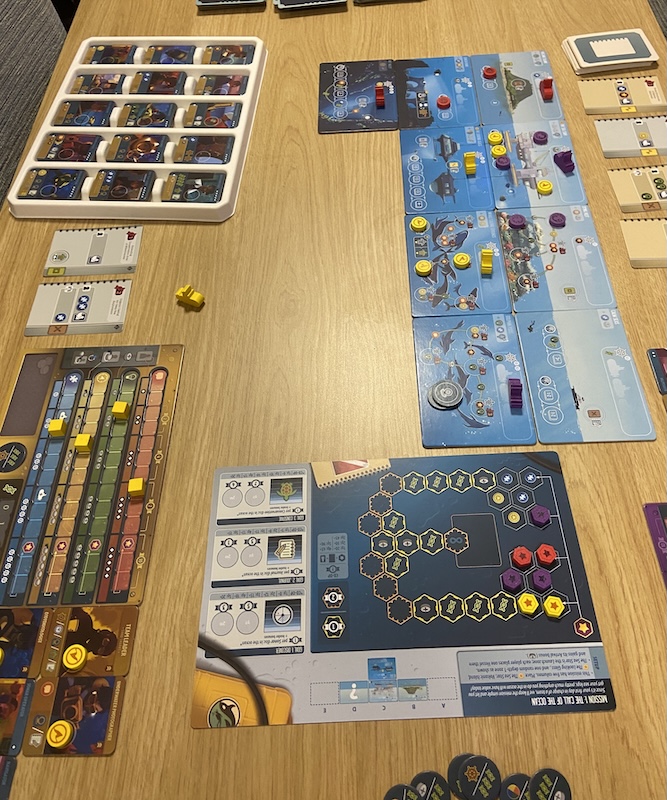
The first table tried Steph’s Endeavor: Deep Sea game, which Jeremy initially mistook for Deep Regrets (a game he was looking to play), but was happy to find a great game of discovery and interesting action management. The aim of the game is to lead a group of marine researchers and compete for various objectives of the chosen scenario to become the best (though there is a coop mode where you all work together to do so). Each turn involves recruiting a new team member, generating action tokens, retrieving some spent action tokens from your team, and then taking actions in turn to explore. There is a neat management angle to the action tokens, as you need to generate extra ones to allow you to perform exploration, but you also need to have team members free of action tokens to perform them!
The main part of your turn is underwater in your sub, you may take actions to move to a different explored location, dive for research, activate the sonar to uncover new locations, write up your findings or do some conservation. Each of these actions are dependent on the location, not all actions are available, and some have extra requirements. You are also limited in where you can move based on your skill track that increases through the game, there are other skill tracks involved with level of team member you can recruit and generating and retrieving action tokens. So there is enough going on to give you different options for your strategy!
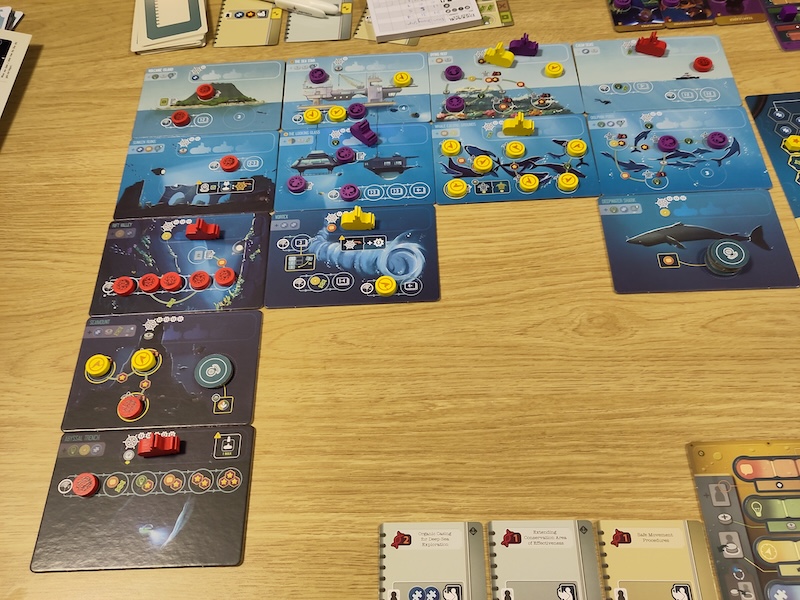
In this game, where Jeremy and Dan were new recruits for the marine exploration, we tried the first scenario focussed on doing the main tasks of sonar, research papers and conservation. Jeremy started by trying to maximise his action tokens, but soon found he couldn’t spend them as he couldn’t remove previous tokens from his team members. Dan managed to get to a turtle conservation area and was concentrating on a team that could help them. Steph was trying to do a bit of everything, but kept running out of actions. In the end after some failed attempts to write a research paper (due to lacking research), Jeremy concentrated on using his teams sonar expertise and diving the depths. Dan continued to roam the seas looking for conservation areas and he maximised his team hiring to get one of the unique personnel. Steph had sorted out her action token problems and was doing some good research - both diving and writing, with some conservation on the side. But with only 6 rounds, it was over too quickly - with Dan the winner - having saved the oceans, Jeremy second with exploring, and Steph the runner up.
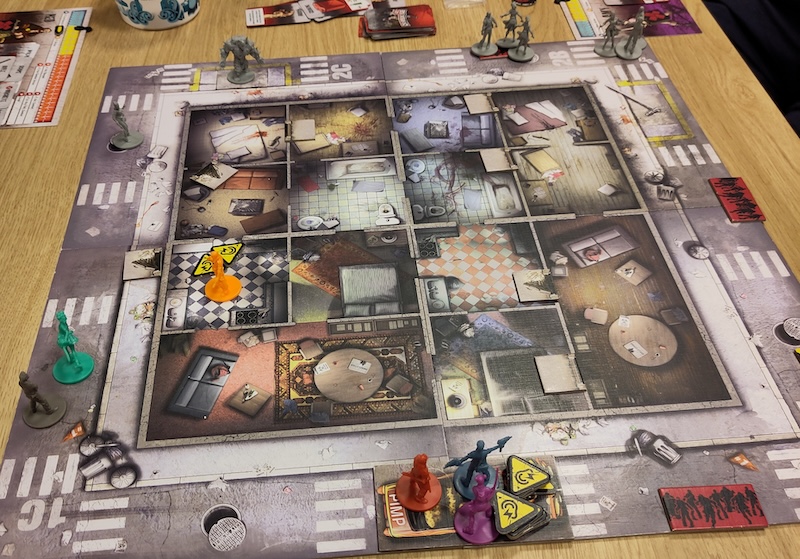
Zombicide was back for its seventh club play making it one of the clubs more popular long games. Four players attempted to survive the zombie hordes. In the first game six characters were setup so two players controlled two characters. The mission story was that everyone had gone to sleep in a safe looking house with the car parked just outside, except it then turned out the zombies were coming and some idiot had left the car keys in the room on the opposite side of the house! So phase one was acquire the car keys, which went quite well, the team made it across the house without triggering too many zombies so none were coming from behind while getting back to the car. Except now the Abomination spawned outside the house and the team realised it was only a four seater car and no playing sardines. So half the team went back in the house searching for the ingredients for a molotov cocktail (the only way to kill an Abomination) while the other half started driving the car around very effectively thinning out the numbers of normal zombies. With some careful coordination the car and the three following behind on foot (or roller skates) made it to the exit zone.
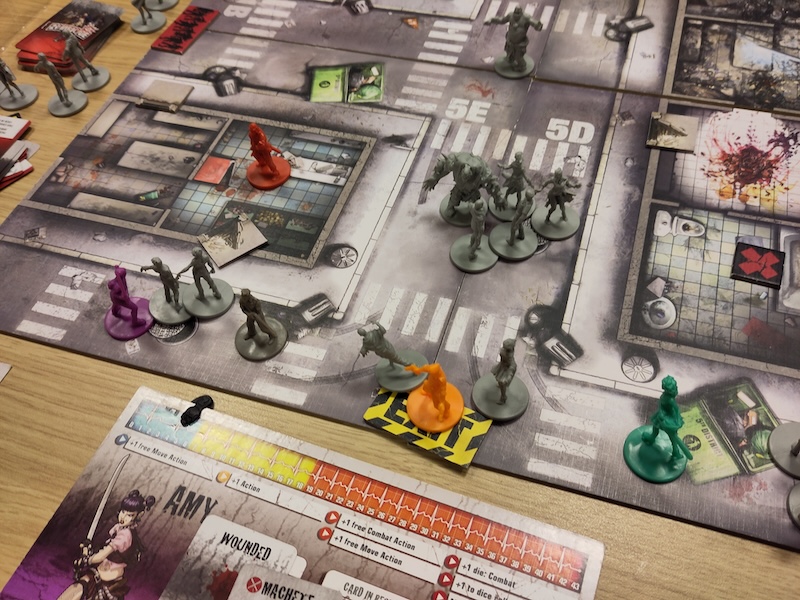
Enthused by this veritable success it was agreed to have a second try at a second short mission. This time the four players needed to rescue their two kidnapped companions and three tins of beans and get everyone to the exit. The first rounds involved a lot of searching, which did generate a decent and varied amount of weaponry, one companion and the tins of beans. However the zombie hordes were now massing in the streets and then the Abomination spawned and we couldn’t find any molotov ingredients! With the odds stacking against us and the hour getting late the game was abandoned before all the characters met a grisly fate.
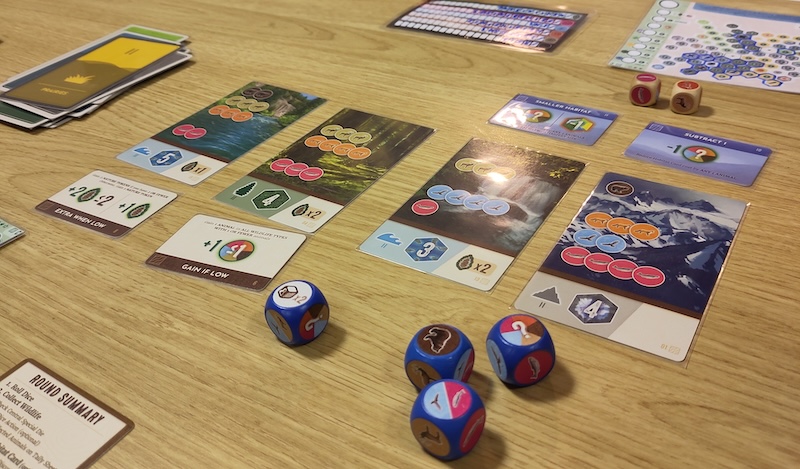
The Endeavor table finished first and had time to fit in a game of Cascadia Rolling Rivers back from Session 106. They jumped into scenario C - Tatshenshini Alsek Rivers - which meant circling (or rather “hexagonning”) hexes on a board to score points and benefits. Steph had tried the Rolling Hills version before - a companion version that can be used to expand the game to 8 players, Jeremy had tried both, and Dan was a new player. The idea is to collect the wildlife from the dice rolled to fulfil the requirements of the habitat cards and thus allow you to fill in your sheet. Its a fiendish game of trying to get the right animals so you can then choose the habitats that get to the more tricky goals on the chosen scenario to help maximise your points. It ended too quickly for Jeremy having missed two goals (trying to get one of each habitat marker and complete the mountainous terrain), where as Steph did complete similar goals. Dan was the winner (again!) as he had clearly sussed the best way to utilise his animals and habitats!
The next session is the 20th August, do remember the new price increase to £7 to cover increased venue hire fees has started. Join us on Discord to help suggest games for the next session or book your seat on a table or just join us on the night and see what is available.
- Total Session Attendance: 11
-
Board Games: